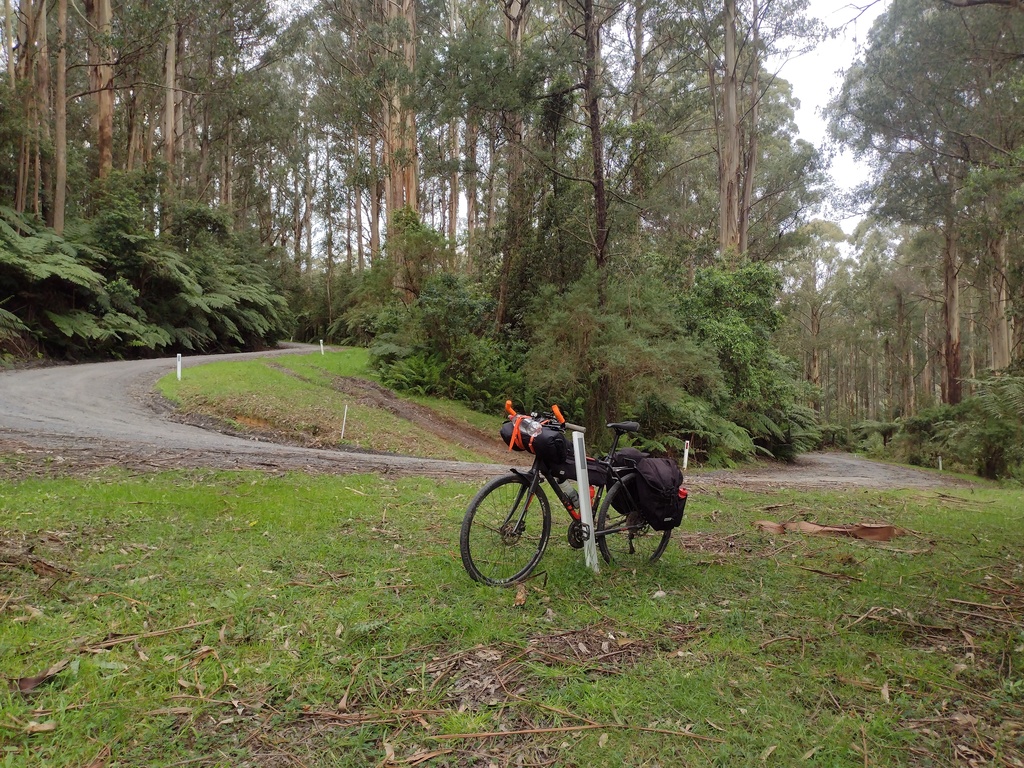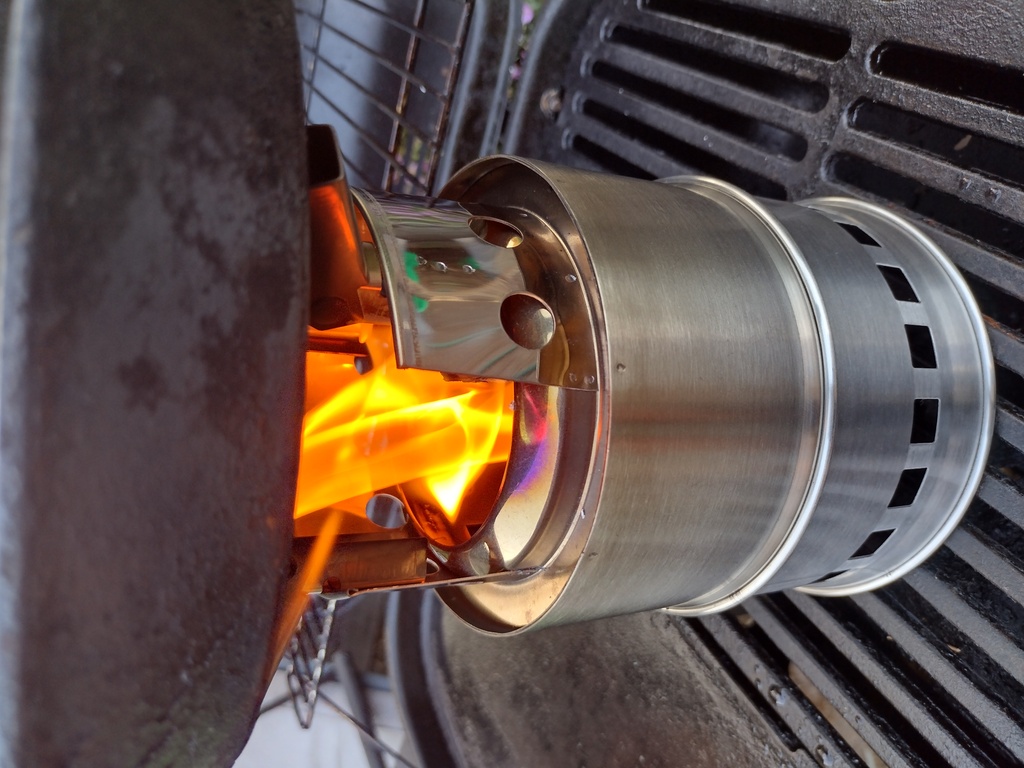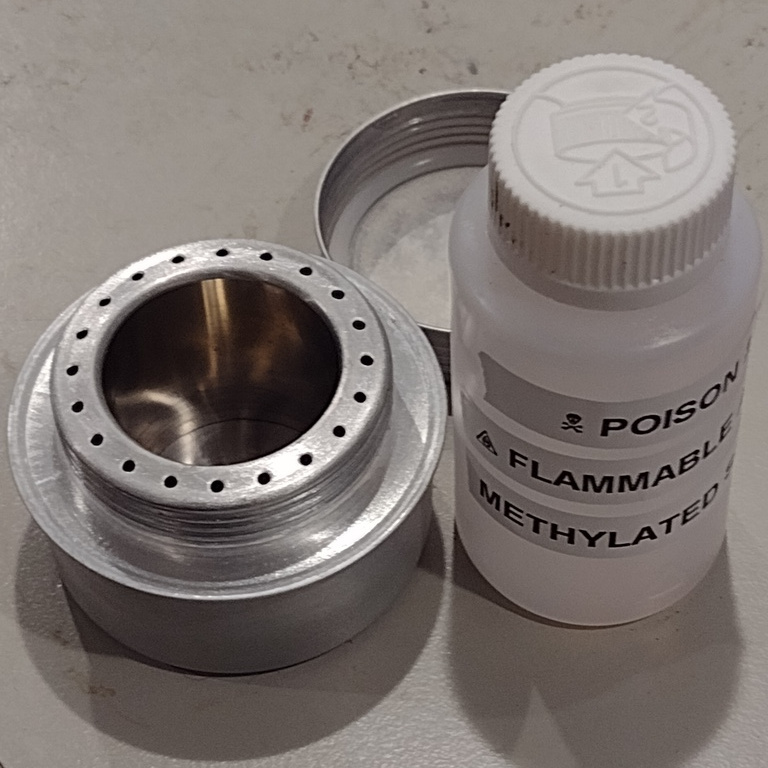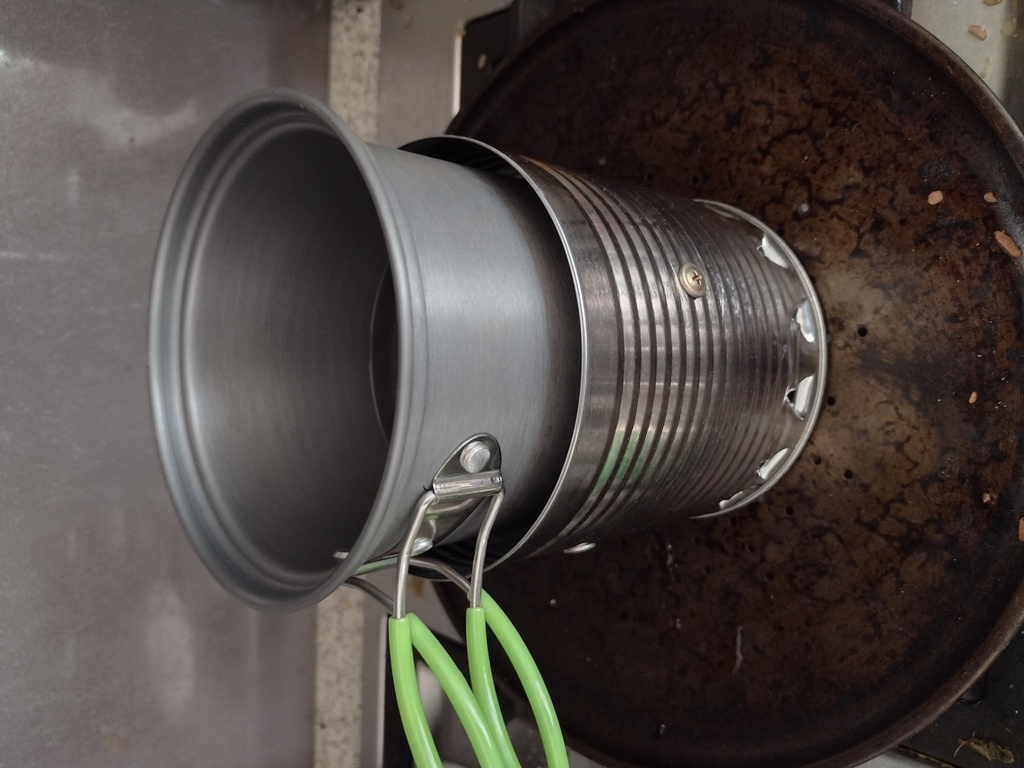Cooking for Weight Weenies
2023-11-24I’ve gotten into bikepacking lately, and as well as learning some stuff about bike mechanics and working on my fitness, I’ve also had to work on how to pack.
A lot of the cheaper stuff mentioned here, including the rocket stove, the
alcohol stove, the stove windshields and the coffee filter was bought from Temu.com.
Also a tiny luggage scale I used for a lot of the weights in this article.
I’ve so far found their deliveries to be super reliable and while they
have some crappy items most of the stuff I’ve bought has been very good
for the price.
If you’re considering trying Temu out you can use
this Temu affiliate link or
coupon code apr43524 and you’ll get some kind of discount /
discount voucher and when you actually buy something I’ll get some
kind of store credit to spend on more random cycling stuff!
The Weight
Weight is a funny thing. My bike fully packed for camping weighs about twice what it does in commuter mode, so it feels horrible when it’s not moving. But all that extra weight only works out to about an extra 15% of so of the combined weight of bike + rider so once we’re moving it really doesn’t make a huge difference.
 Packed for camping, on Blacksands Road, near Warburton
Packed for camping, on Blacksands Road, near Warburton
There’s lots of different ways to save weight but lightness costs money so you’ve got to be a bit organized to work out where to save weight economically. You can spend a lot of money shaving grams off bicycle parts but generally the best place to start is with the heaviest stuff, and one of the heaviest parts of camping gear is cooking equipment.
To decide where to more effectively save weight, weigh everything:
| Item | Weight, g | Cost, $ |
|---|---|---|
| Snowpeak Titanium Splade | 15 | 15.00 |
| The fanciest looking full sized steel fork I could find in my kitchen cutlery drawer, which you could buy from a thrift store for fifty cents |
51 | 0.50 |
So you’re spending $14.50 to save 35 grams, or to put it another way this weight saving is costing you $.40 per gram. By comparison, a cheap lightweight chair weighs 900g and costs about $50, whereas the Helinox Zero weighs 500g and costs $149. So reducing that weight is only costing you $.24 per gram.
So, is buying titanium cutlery an economically effective way to save weight? No.
Do I love my titanium splade anyway? Yes.
On the other hand, replacing four steel bottle cage screws with four titanium bottle cage screws would cost $35 for 10g weight saved, that’s $3.50 per gram saved, so it could be worse. It could always be worse.
Stoves for Weight Weenies
Stoves provide a way of heating food and also boiling water to sterilize it or just for a cup of tea and a nice hot water bottle on a cold night. But they’re one of the heaviest bits of kit you’ll carry.
You can do without and eat cold bean tortillas for every meal. That is definitely a thing you could choose to do. Or everywhere you go you could build a tiny fireplace out of twigs and out of bark and cook over the coals, but it’s pretty time consuming way to do it.
So mostly it’s practical to have some kind of stove, and thankfully they’re one of the cheapest opportunities to reduce weight.
Gas Stoves
I have a couple of options in gas-burning stoves, a cheap mini burner from Ebay which screws to the top of a gas can, and a Kovea Moonwalker stove which has its own tripod and attaches to the can via a long flexible pipe.
| Item | Weight, g |
|---|---|
| Gas Stove (mini) | 115 |
| Gas Stove (kovea) | 354 |
| Gas Can Tripod | 32 |
| 220g Gas Can (almost empty) | 174 |
| 220g Gas Can (new) | 381 |
| Windshield (tall, halved) | 109 |
| Windshield (short, halved) | 52 |
There’s a few interesting things to note here.
The windshields are made of multiple panels of alumnium joined with steel hinge wires. They were both originally twice as long (and twice as heavy), but I shortened them by removing half the panels, as butane stoves only really need a shield on the upwind side. The moonwalker is very low which means it is is very stable and doesn’t need a proper windshield in most conditions, you can just leave a pack or some sticks upwind and that’ll work. But I’ve included a low wind shield in the numbers just to be fair.
 Mini gas stove, with canister tripod and small pot
Mini gas stove, with canister tripod and small pot
Bringing the mini gas stove (115g) instead seems like it saves a fair bit of weight over the Kovea (354g), saving 239g but it requires a taller wind shield and a clip-on plastic tripod for the gas canister, so the difference is only 150g, plus the Kovea stove is better at simmering, far more stable and will work at lower temperatures due to its evaporator loop.
Both those stoves use isobutane fuel canisters so there’s also about 180-380g
of fuel canister to carry, depending on how full it is.
There are smaller 100g cans available but they’re hard to find cheaply.
Heating up a typical meal takes about 10g of gas with the tiny gas stove, although I haven’t done methodical testing here. The Kovea is probably more efficient too.
as an aside: you really want to use fuel cans filled with Isobutane and/or Propane, because regular Butane stops evaporating at around 0⁰C … which can really cramp your style on a cold morning when your gas fuel stays a liquid instead of burning. If you can only find Butane and it’s going to be chilly overnight it’s best to keep the can in the foot of your sleeping bag along with your microfilter!
Rocket Stove
A rocket stove is really just a mechanism for burning small bits of wood at high temperature in copious air, resulting in highly efficient burning. There’s a few different ways to make this work, and I’m not sure there’s a precise definition of what is and isn’t a rocket stove.
My rocket stove is just an inexpensive assembly of stacking double-walled stainless steel tubes. When packed away the parts nest neatly inside each other. The double stainless steel walls keep a lot of heat in and reflect radiant heat back into the center. Fresh air is drawn in at the bottom, heated between the walls and reintroduced at the top where it causes any wood gases to be completely burnt off. Based on the blue color of the stainless steel it’s producing temperatures up to 300⁰C.
This one is from Temu but you could also make one out of a couple of cans.
 Rocket Stove
Rocket Stove
Because of the highly efficient burn you can cook dinner over scraps of wood which would be regarded as barely adequate kindling for getting a regular campfire started.
| Stove | Fuel | Windshield | Legs | Total | |
|---|---|---|---|---|---|
| Mini | 115 | 300 | 109 | 32 | 556 |
| Kovea | 354 | 300 | 52 | 0 | 706 |
| Rocket | 586 | 0 | 0 | 0 | 586 |
Looking at overall weight, the rocket stove (586g) is actually lighter than the Kovea stove plus windshield and nominal 300g gas can. And it runs on sustainable free fuel you find laying on the ground in every bush campsite, plus you can burn off your paper trash in it, and it gives off a cheery campfire light.
Of course, there are places and conditions where a gas stove is safe/permitted and a rocket stove isn’t, or where dry kindling is hard to find. Plus the rocket stove has to cool down before you can pack it up and it covers all your cookware in soot (not as much as an open fire, but still), so it’s not as clear cut as all that.
Also: don’t forget your matches.
Alcohol stoves
In this article I’d originally dismissed alcohol burners like the trangia as “horribly slow” but I went and bought a cheap one anyway just so I could give it a go for you, good reader.
 Metho-burning stove with fuel bottle
Metho-burning stove with fuel bottle
Maybe I’ve become more patient in my old age but five minutes to boil 250mL of water is … well it isn’t quick but then again it’s not that bad.
| Item | Weight, g |
|---|---|
| Alcohol Stove | 30 |
| Fuel bottle 100 mL | 25 |
| Liquid fuel ~95 mL | 75 |
| Trivet | 25 |
| Windshield | 52 |
| TOTAL | 207 |
30 grams seems amazingly low weight compared even to the mini butane burner, but doesn’t include fuel or any kind of windshield or trivet to place your pot on, and without those the stove isn’t usable. Like the rocket stove, but unlike the gas stoves, you can’t turn it up or down so it’s pretty much a fast boil or nothing: simmering isn’t really possible.

For test purposes, I made a trivet/windshield out of a Milo can which is efficient but not very portable. Since then I’ve got a tiny flexy stainless windshield which also works as a trivet and weighs almost nothing. It’s not very stable, but if ultralight is what you want that’s the price you pay.
For comparison, a Trangia cookset with burner, windshield/pan support, two pots and a frypan is about 845g without fuel.
Methylated Spirits fuel is quite cheap and it only took about 10g / 12mL to vigorously boil a cup of water so a little 100mL bottle should last for a short trip (in case you’re wondering: ethanol is less dense than water, about 0.8 g/mL)
Methylated Spirits contain horribly toxic Methanol so it is really important to use a well-sealed, childproof bottle for your fuel. I’ve saved a couple of kids’ liquid medicine bottles which have those push-and-twist lids on them, in various sizes. Be sure to relabel appropriately to make sure no-one mistakes the fuel for a really terrible cough remedy.
Other kinds of stove
Hexamine (solid fuel tablet) stoves might also be worth considering for short trips. They’re compact, low weight and easy to light but as I understand it not particularly fast to cook over.
Pressurized Shellite / Naptha / White Gas stoves have their loyal adherents, but I’ve always found them terrifyingly erratic, with blocked jets, leaking o-rings and sudden flare-ups.
- MyLifeOutdoors (youtube) compares several types of stove including canister, alcohol and solid fuel.
Cookware
As well as three stoves I’ve got three lots of cookware … okay, so I have a problem.
| Item | Weight, g |
|---|---|
| Small pot & lid with folding handles | 220 |
| Swedish Army mess kit | 465 |
| Large double pot & lid & handle | 555 |
The small pot is just the right size to fit a gas canister, gas can tripod and mini stove inside. it’s just big enough to cook some sausage and tinned beans or something like that. It has plastic-coated folding handles which mean it’s not really suitable for use on a fire or on the rocket stove though.
The Swedish Army mess kit is an aluminum billy with a loop handle and a matching saucepan/lid with a fold-out steel handle. It fits the kovea stove really nicely inside (but not the gas canister). Mine didn’t come with the windshield or the alcohol burner, but rest assured I did not pay $200 for it. I’ve had it for years and it works well on the gas burner, on coals or suspended over a fire. It’s possibly a bit small for the rocket stove, across the narrow axis.
The large cookset has two pans which share a lid, and is just the right size to fit the rocket stove inside. And both pots are a nice size to fit on top of the rocket stove without too much heat getting lost up the sides. There’s no handles, so you need a separate clip-on one (30g) to pick the pots up by.
So I guess the options match up pretty nicely:
| Stove | Cookset | Stove (etc), g | Cookset, g | Total, g |
|---|---|---|---|---|
| Alcohol | Small | 207 | 220 | 427 |
| Mini | Small | 556 | 220 | 776 |
| Kovea | Swedish | 706 | 465 | 1171 |
| Rocket | Large | 586 | 555 | 1171 |
| Kovea | Large | 706 | 555 | 1261 |
… and if I’m going for minimal weight it’s the alcohol stove, or maybe the mini stove but hang on to a half-empty fuel canister to save a little weight. If cooking for two, the large cookset is going to be more practical, either over the rocket stove if weather isn’t too hot or too wet otherwise over the Kovea. Decisions, decisions, decisions.
Additional stuff
Don’t forget you’ll also need some utensils: at the very least a plastic splade and probably something longer to stir with. Unless you want to eat with tent pegs and tyre levers I suppose but that might be a bit too much weight weenie even for me.
Unless you’re doing exclusively dehydrated or boil-in-the-bag stuff you’ll need something to wash up with too. I saw a great tip somewhere to keep those mesh bags oranges come in because they make great pot scourers but also take up no room and dry very quickly.
Coffee for Weight Weenies
I do like a decent cup of coffee in the mornings, but also I really don’t want to carry a whole lot of extra weight to do so.
 coffee makers
coffee makers
| Item | Weight, g |
|---|---|
| Bialetti Caffettiera (stainless) | 526 |
| Wacaco Minipresso | 400 |
| Single-shot Caffettiera (aluminium) | 250 |
| Aeropress | 160 |
| Aeropress without plunger | 87 |
| Stainless conical filter | 10 |
On the motorcycle, I used to schlep that stainless caffettiera / moka pot everywhere and it makes a good coffee but I didn’t often have to push it up hills so the weight didn’t worry me. The classic aluminium ones are a bit less heavy but don’t last long under camping conditions, in my experience: they go all weird and furry inside. Maybe that’s just the Australian river water.
I’ve used a Minipresso a lot on camping trips and at home and it makes a really excellent coffee. The Wacaco website says it weighs 360g but I measure it as 400g, perhaps mine is an older model.
Depending on your feelings about luxury items, it is maybe a bit heavy and fiddly for bikepacking use. There’s a lot of individual parts and if you lose any of them the thing is worthless. Interestingly, they have new “smaller, lighter” models but according to the website they’re a bit smaller but not very much lighter, still over 300g.
A lighter alternative is the Travel Aeropress, which is really just a robust plastic cylinder with a holder for a paper filter at the bottom and an airtight plunger to force the coffee through the filter. That’s only 160g, and to be honest unless you’re in a huge rush you might as well leave the plunger at home and just let it drip through in its own good time: the coffee isn’t really espresso-like even when pushed and without the plunger it weighs only about 87g. You can get stainless filters for these too if you don’t like the disposable paper ones, but I haven’t tried them.
Or why not dispense with the cylinder and the disposable paper filters and just bring the filter? A conical stainless steel filter folds flat, weighs about 10g and just sits inside your coffee cup until you reckon its brewed enough and then lift it up and let it drain.
 Coffee Filter
Coffee Filter
Congratulations, you’ve just saved about the weight of a tin of beans or a cold, refreshing canned beverage. Or maybe even a tiny chair.
Conclusion
You could save a kilo by spending a few thousand bucks on a lighter bike, or spending a few hundred bucks on lighter camping gear or you could spend nothing and just eat cold beans with a tyre lever.
Or you could just bring your credit card and stay at a nice B&B.
There’s many ways to do it but hopefully you’ve enjoyed joining me in pondering the details from the comfort of your sofa, rather than bemoaning your fate as you drag a kitchen sink up the side of a mountain.
And, yeah, I went and bought that 500g chair. Because of course I did. After all, I’d just saved 500g on a coffee filter …